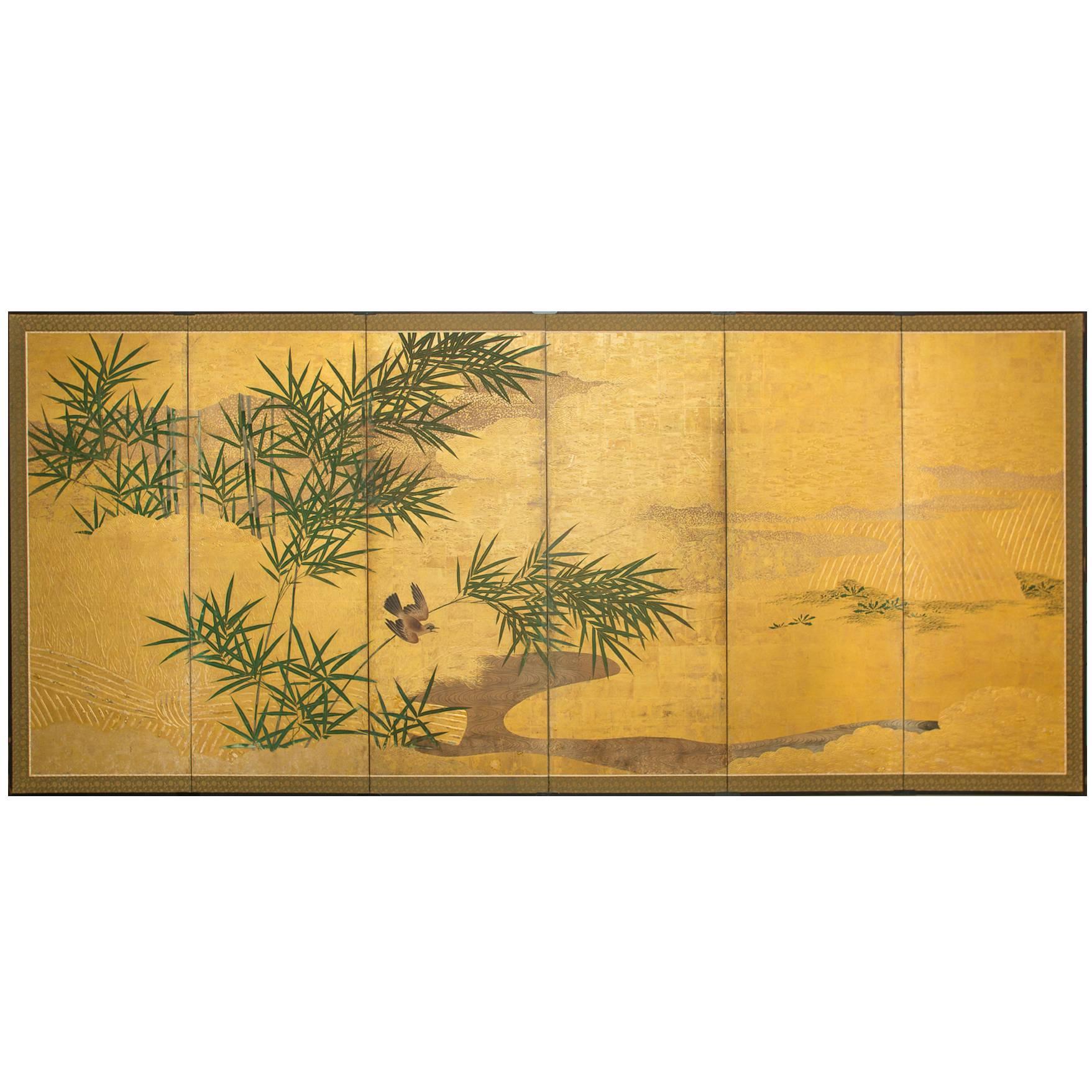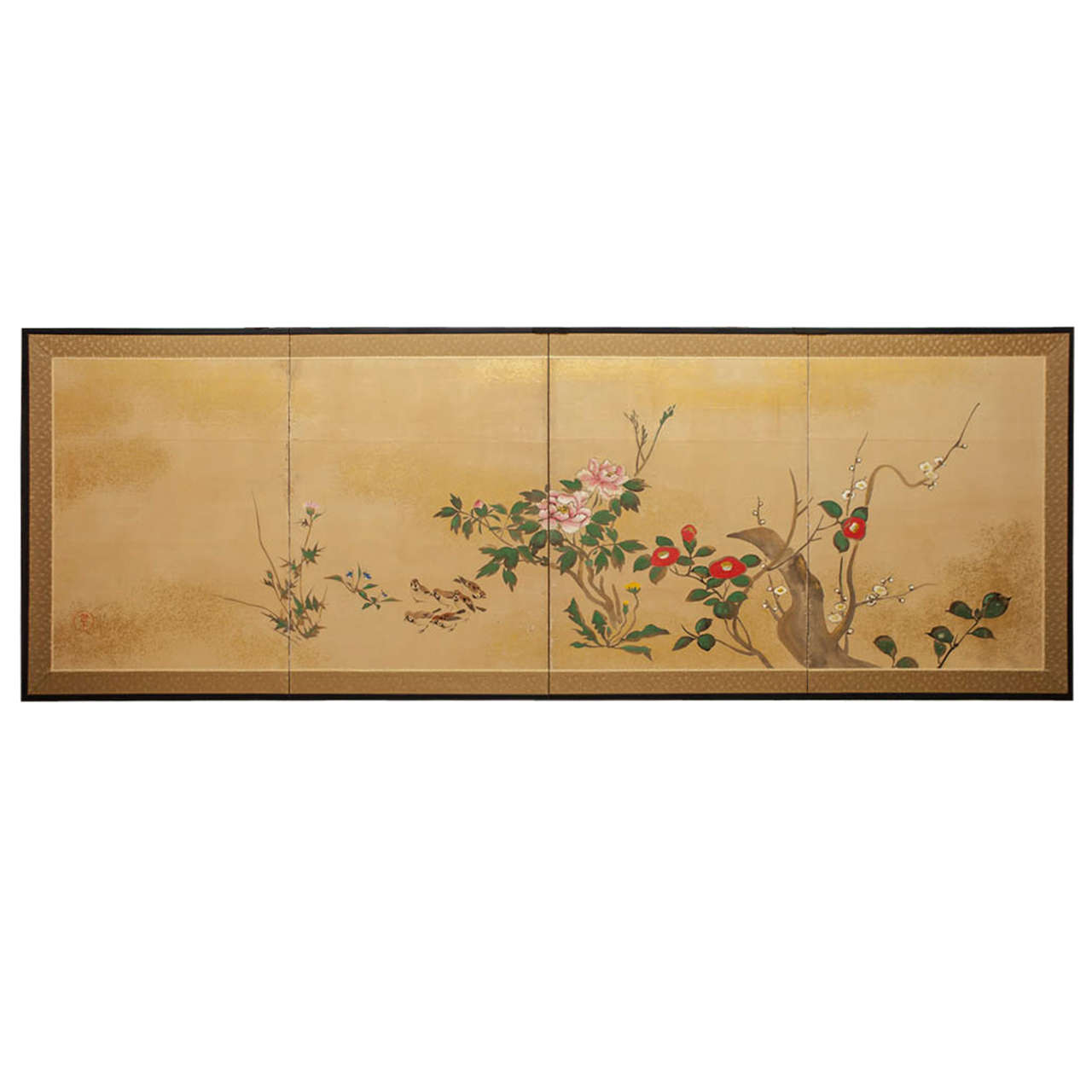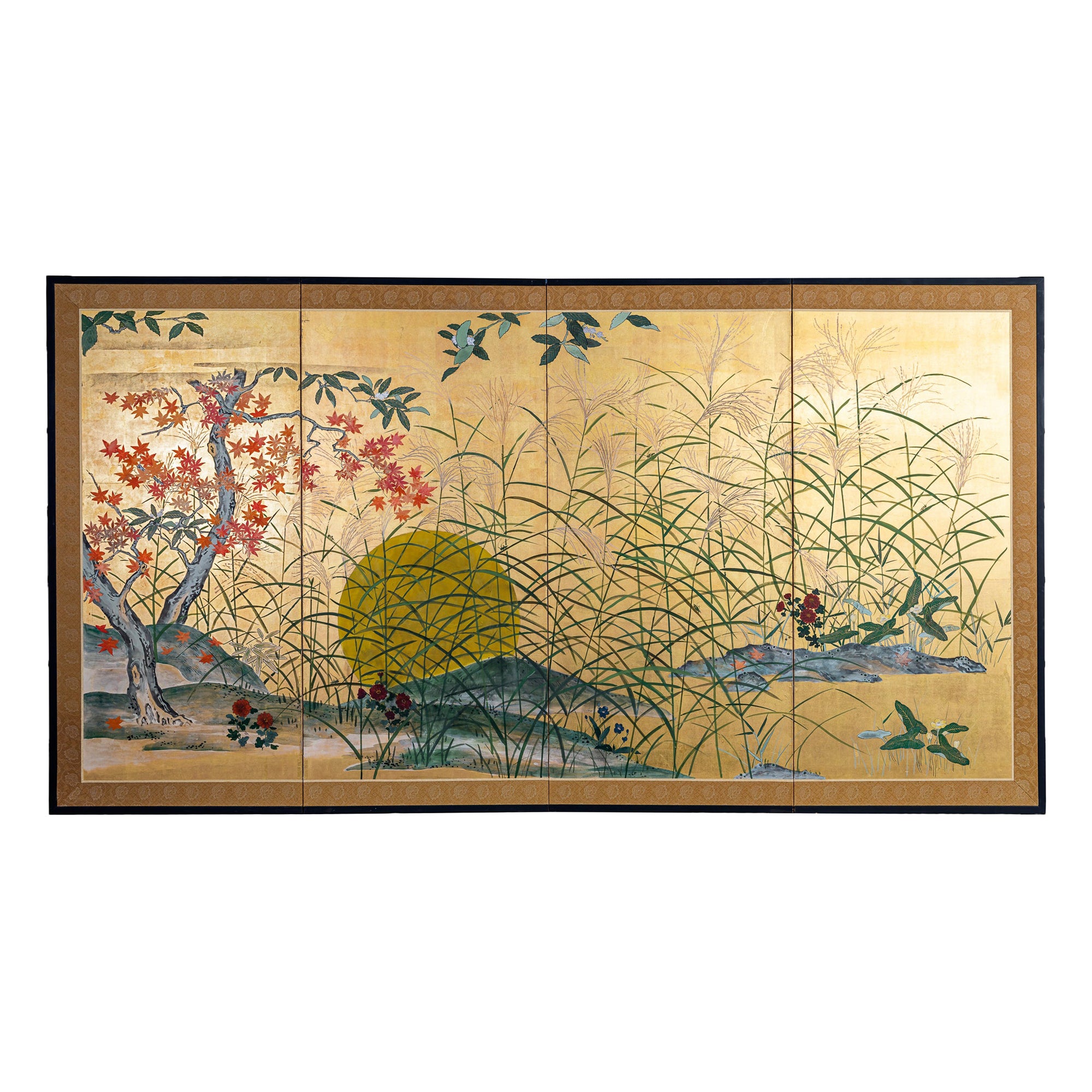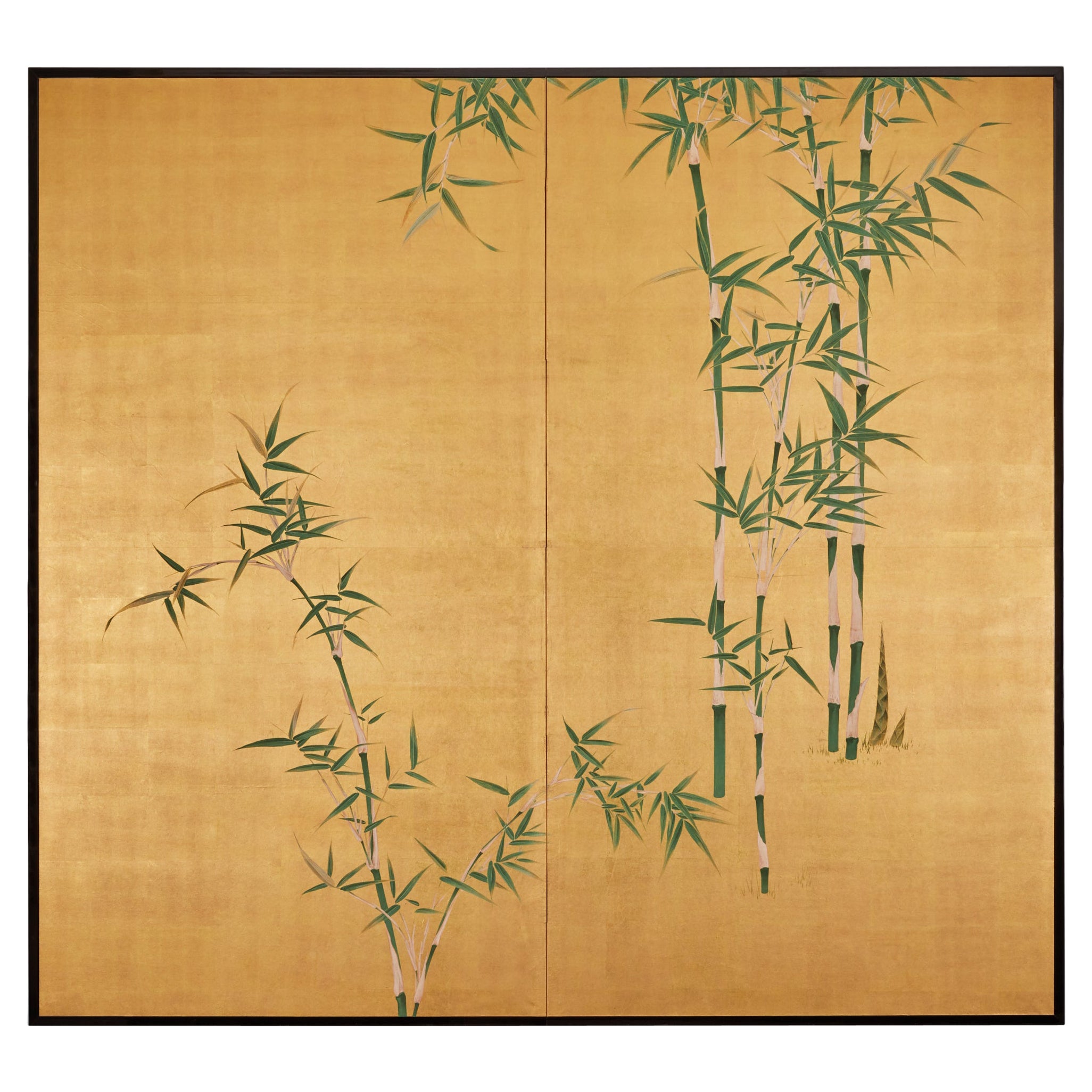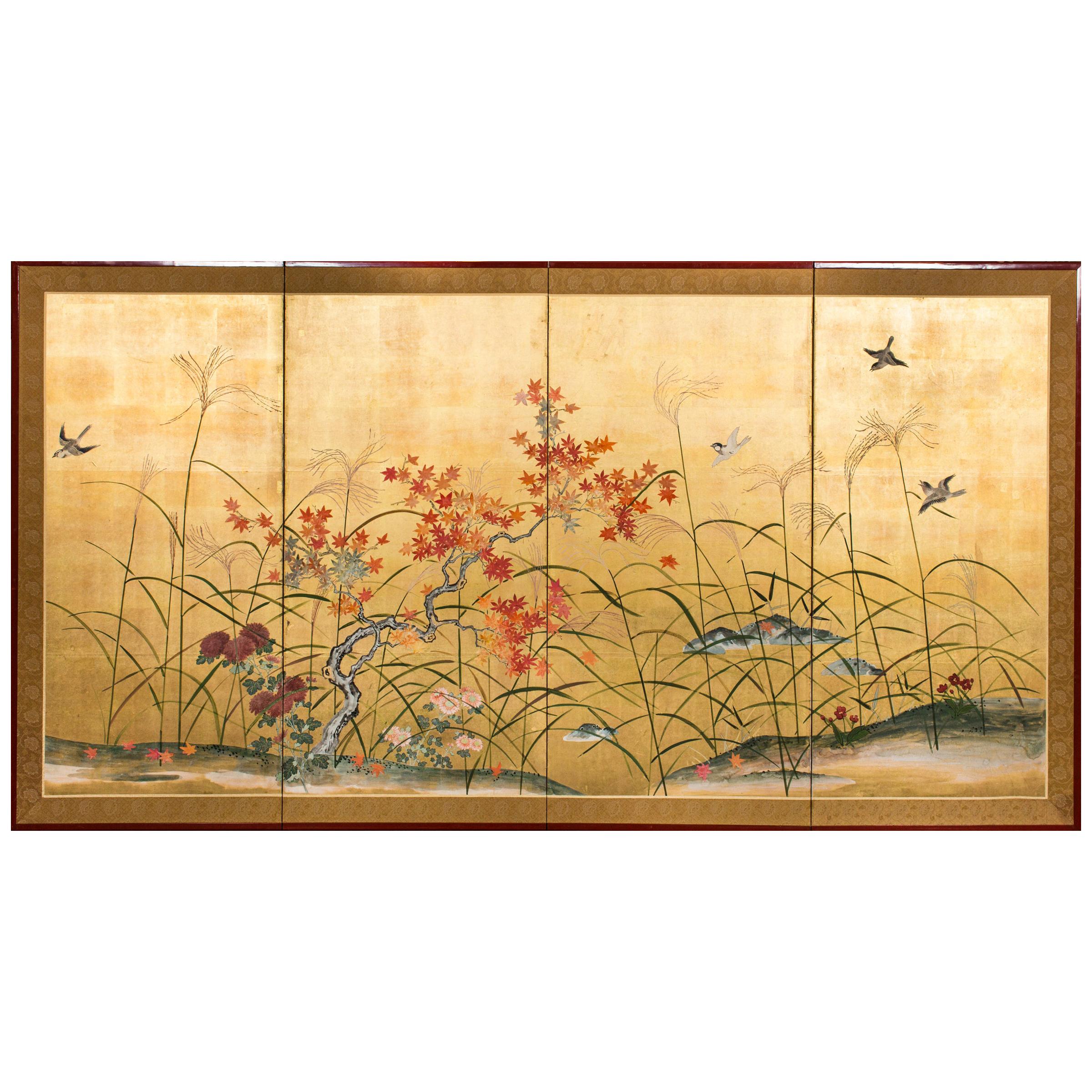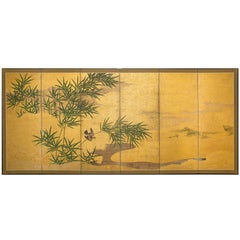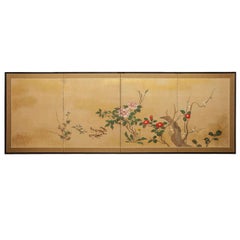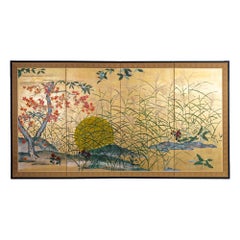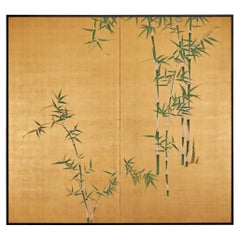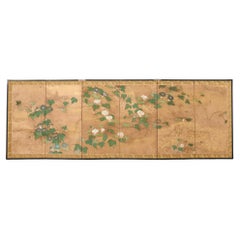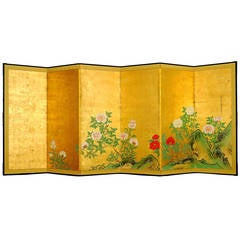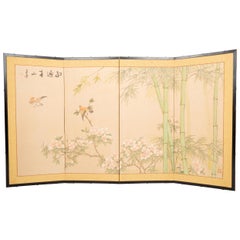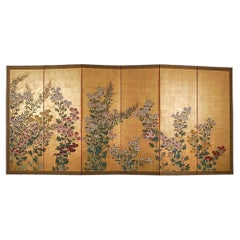Items Similar to Japanese Four-Panel Screen, Young Bamboo and Morning Glory
Want more images or videos?
Request additional images or videos from the seller
1 of 8
Japanese Four-Panel Screen, Young Bamboo and Morning Glory
$15,000
£11,468.30
€13,209.16
CA$21,019.60
A$23,466.41
CHF 12,296.04
MX$287,251.84
NOK 156,159.88
SEK 147,238.94
DKK 98,581.34
About the Item
Mineral pigments on gold, signature reads: Okyo.
- Dimensions:Height: 49.5 in (125.73 cm)Width: 92 in (233.68 cm)Depth: 1 in (2.54 cm)
- Place of Origin:
- Period:
- Date of Manufacture:circa 1900
- Condition:Details on request.
- Seller Location:Hudson, NY
- Reference Number:Seller: S15621stDibs: LU85518780853
About the Seller
5.0
Recognized Seller
These prestigious sellers are industry leaders and represent the highest echelon for item quality and design.
Established in 1971
1stDibs seller since 2008
166 sales on 1stDibs
Typical response time: 10 hours
Associations
The Art and Antique Dealers League of AmericaAntiques Associations Members
- ShippingRetrieving quote...Shipping from: Hudson, NY
- Return Policy
Authenticity Guarantee
In the unlikely event there’s an issue with an item’s authenticity, contact us within 1 year for a full refund. DetailsMoney-Back Guarantee
If your item is not as described, is damaged in transit, or does not arrive, contact us within 7 days for a full refund. Details24-Hour Cancellation
You have a 24-hour grace period in which to reconsider your purchase, with no questions asked.Vetted Professional Sellers
Our world-class sellers must adhere to strict standards for service and quality, maintaining the integrity of our listings.Price-Match Guarantee
If you find that a seller listed the same item for a lower price elsewhere, we’ll match it.Trusted Global Delivery
Our best-in-class carrier network provides specialized shipping options worldwide, including custom delivery.More From This Seller
View AllJapanese Six Panel Screen: Bamboo Grove with Bird and Meandering Stream
Located in Hudson, NY
Japanese Six Panel Screen: Bamboo Grove with Beautifully Painted Bird and Meandering Stream. Excellent Rimpa School painting with very finely rendered bird, raised gold fencing, wit...
Category
Antique Mid-18th Century Japanese Paintings and Screens
Materials
Gold Leaf
Price Upon Request
Japanese Four Panel Screen: Early Spring Into Summer
Located in Hudson, NY
Japanese Four Panel Screen: Early Spring Into Summer, Meiji period (1868 -1912) painting of plum in bloom with red camellias on the right and peony and thistle on the left. A clutc...
Category
Antique Early 1900s Japanese Meiji Paintings and Screens
Materials
Gold Leaf
Japanese Four Panel Screen: Autumn Flowers and Moon on Gold
Located in Hudson, NY
Mineral pigments on gold leaf.
Category
Early 20th Century Japanese Paintings and Screens
Materials
Gold Leaf
Japanese Two Panel Screen: Young Bamboo on Gold
Located in Hudson, NY
Symbolizing the Sun, gold is often used in shrines and temples in Japan. Gold has been extensively recognized to represent wealth, while bamboo is said to bring good luck due to its ability to regenerate in the forest. A beautiful composition of the two together...
Category
Antique Late 19th Century Japanese Paintings and Screens
Materials
Gold
Japanese Four Panel Screen, Autumn Flowers
Located in Hudson, NY
Taisho period painting (1912-1926) of a fall landscape with wild grasses, red maple, and dahlias. Mineral pigments on gold with a silk brocade border and beautiful metal mounts.
Category
Vintage 1920s Japanese Taisho Paintings and Screens
Materials
Silk, Wood, Paper
Japanese Six-Panel Screen, a Garden for All Seasons
Located in Hudson, NY
An imaginary garden with flowers from all seasons including spring lilies, summer hibiscuses, autumn chrysanthemums, and winter berries. Wild autumn grasses move in a soft breeze wit...
Category
Antique 1890s Japanese Meiji Paintings and Screens
Materials
Gold Leaf
You May Also Like
Japanese Edo Six Panel Screen Flowering Morning Glory
Located in Rio Vista, CA
Spectacular 19th century late edo period six panel byobu screen featuring flowering morning glory vines (as-agao). Machi-eshi or anonymous town artist painter crafted in an amalgamat...
Category
Antique 19th Century Japanese Edo Paintings and Screens
Materials
Brass
Antique Japanese Six-Panel Screen by Kano Chikanobu "Shushin"
Located in Prahran, Victoria
Late 17th century Kano school peony landscape screens. Both screens signed: Hogan Josen Fujiwara Chikanobu Hitsu - Kano Chikanobu (Shushin) (1660 - 1728...
Category
Antique Early 18th Century Japanese Edo Paintings and Screens
Materials
Gold Leaf
Japanese Four Panel Taisho Period Screen Bamboo & Blossom, circa 1920
Located in London, GB
Japanese four panel Taisho Period (1912-1926) screen. Depicting bamboo, blossom and birds in flight. Signed.
Mineral pigment on mulberry paper with silk brocade border, within a lac...
Category
Vintage 1920s Japanese Taisho Paintings and Screens
Materials
Silk, Paper
Japanese Six-Panel Screen Byobu With Chrysanthemums And Autumn Grass and Flower
Located in Torino, IT
The 19th Century Six-Panel Japanese folding screen "Byōbu" usually used in the most important Japanese house to stop wind and also to separate different space of the same big room de...
Category
Antique Mid-19th Century Japanese Edo Paintings and Screens
Materials
Gold Leaf
Japanese Folding Screen Landscape paint on Gold Leaf Six Panels
By Japanese Studio
Located in Brescia, IT
Folding screen depicting a landscape by a painter of the Rinpa school, early 19th century.
Six panels painted in ink on gold leaf and "gofun" on vegetable paper.
Rinpa is one of the ...
Category
Antique Early 19th Century Japanese Edo Paintings and Screens
Materials
Gold Leaf
19th Century Japanese Screen for Tea-Ceremony, Ink Bamboo and Plum on Gold Leaf
Located in Kyoto, JP
Three Friends of Winter
Nakajima Raisho (1796-1871)
Late Edo period, circa 1850
Ink and gold leaf on paper.
This is a double-sided Japanese Furosaki or tea-ceremony screen from the mid 19th century; bamboo and plum on the front, young pines the back. It by Nakajima Raisho, a master painter of the Maruyama school in the late Edo and early Meiji periods. In this work Raisho combines exquisite ink brushwork with large open spaces of brilliant gold-leaf to inspire the viewers imagination. Rather than naturalism, he is searching for the phycological impression of the motifs, resulting in abstraction and stylization. His simplification of the motifs the result of looking to capture the inner nature of the objects. This art motif is known as Sho Chiku Bai, or the Three Friends of Winter. Evergreen pine connotes steadfastness, bamboo suggests both strength and flexibility, while plum blossoms unfurling on snow-laden branches imply hardiness. Combined, this trio is emblematic of Japanese new year. Chinese literati were the first to group the three plants together due to their noble characteristics. Like these resilient plants flowering so beautifully in winter, it was expected of the scholar-gentleman to cultivate a strong character with which he would be able to show the same degree of perseverance and steadfastness even during times of adverse conditions.
The screen would have been placed near the hearth of a room used for the Japanese tea ceremony, shielding the fire from draughts and also forming a stimulating and decorative backdrop behind the tea utensils. It would have been used in the Hatsugama, or first tea-ceremony of the new year.
Nakajima Raisho (1796-1871) originally studied under Watanabe Nangaku before entering the school of Maruyama Ozui. He was the highest ranking Maruyama school painter at the end of the Edo period and was known as one of the ‘Four Heian Families’ along with Kishi...
Category
Antique Mid-19th Century Japanese Edo Paintings and Screens
Materials
Gold Leaf
More Ways To Browse
Morning Glory
Morning Glory Antique
Japanese Screen 20th Century Four Panel
Chinese Screen With Birds
Edo Scroll
Hand Painted Kimono
Scroll Japanese Birds
Kano School
Japanese Silk Art Landscape
Chinese Silk Scroll
Gold Crane Japanese
Painting On Wood Bamboo
Bird Paintings On Silk
Japanese Peacock
Chinese Four Panel Screen
Chinese Ink On Silk
Japanese Scroll Landscape Painting
Ming Dynasty Painting
